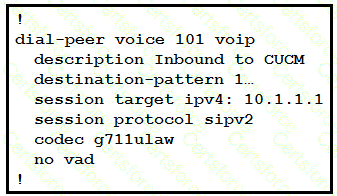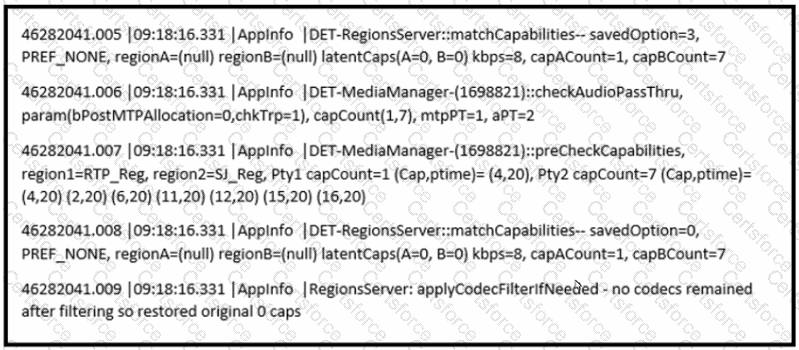An administrator discovers that employees are making unauthorized long-distance and international calls from logged-off Extension Mobility phones when the authorized users are away from their desks Which two configurations should the administrator configure in the Cisco UCM to avoid this issue? (Choose two.)
Why would RTP traffic that is sent from the originating endpoint fail to be received on the far endpoint?
The Cisco Unified Communications Manager Dialed Number Analyzer allows analysis of calls from which two devices? (Choose two.)
Refer to the exhibit.

A Cisco Unified Border Element continues to send 180/183 with the required: 100rel header to Cisco UCM. and the call eventually disconnects How is the issue resolved?
The SIP session refresh timer allows the RTP session to stay active during an active call. The Cisco UCM sends either SIP-INVITE or SIP-UPDATE messages in a regular interval of time throughout the active duration of the call. During a troubleshooting session, the engineer finds thatthe Cisco UCM is sending SIP-UPDATE as the SIP session refresher, and the engineer would like to use SIP-INVITE as the session refresher. What configuration should be made in the Cisco UCM to achieve this?
Refer to the exhibit.

Users report that when they dial the emergency number 9911 from any internal phone, it takes a long time to connect with the emergency operator. Which action resolves this issue?
An engineer must implement call restriction to toll-free numbers using a class of restriction in a branch Cisco UCME. In which two places is the corlist incoming or cor Incoming command configured? (Choose two.)

Refer to the exhibit. When setting up a new connection to Cisco UCM, the engineer must use out-of-band DTMF. Which configuration meets this requirement?
When locations-based Call Admission Control denies the call, which two masks can AAR apply when routing the call through the PSTN? (Choose two.)
Exhibit.

Refer to the exhibit. All calls from site A to site B are failing, and the issue has been identified as a media negotiation problem. Which configuration change resolves the issue?